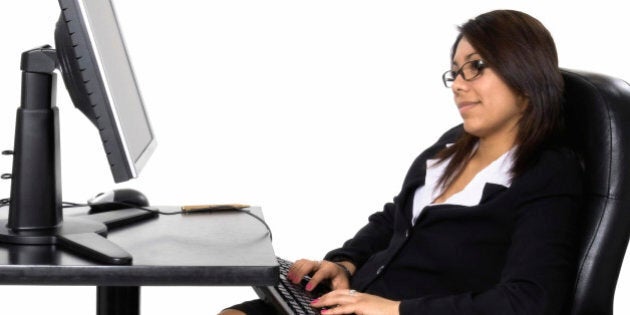
There's no question our society has a posture problem. Between hunching down over our desks, carrying around way too much, heck, sitting all the time, our bodies are not working at their best, and it's time we improved them.
We've taken a look at exercises to save your back in the past, as well as stretches to help when you've been slouching. But now we want to check out the cause of the problem, and it starts no further than however you're reading this article right now.
It's incredibly easy to start using one side of your body more than the other in day-to-day tasks, thereby weakening the muscles and increasing the potential for not only more slumping, but actual harm to your body as well. Massage therapist Danielle Chow-Leong, who recently attended the World Relays in the Bahamas with Team Canada, has given us some tips about how we're throwing off our bodies every day — and what we can do to fix that.
Carrying Your Purse
"Women's purses tend to be oversized and filled to capacity, and that puts a lot of weight on one shoulder," says massage therapist Danielle Chow-Leong. "This tends to make us round our shoulders, which shortens our pectoral muscles and puts more stress on our upper back and neck muscles. Pectoral muscles rarely hurt, but compensatory muscles become hypertonic (tight), may spasm or even give off a burning sensation."
How to fix it: Wear a knapsack instead of a large purse on one shoulder, Chow-Leong suggests, or a crossbody bag (which tends to be smaller, giving you less room to stuff heavy things into it). If you want to keep carrying your purse, change up the side you wear it on for half the day.
Sitting With Your Wallet In Your Pocket
"Sitting with your wallet in your back pocket can cause increased compression to gluteal and piriformis (butt) muscles," says Chow-Leong. "The increased height on one side causes a shift in the pelvis if sitting is prolonged. This can also cause increased shortening of other muscles surrounding the hip. Blood supply and nerve supply can be compromised, which may cause numbness and tingling down the affected limb."
How to fix it: Remember to take your wallet out and put it on the table when you're at work or at a restaurant.
Sleeping On Your Stomach
"Sleeping on the stomach causes a hyperlordic (arched) curve in the back, and depending on which side your neck is turned to, shortening of those neck muscles as well," explains Chow-Leong. "It will cause shortening of the psoas (the muscle between your trunk and your legs), quads and lower back muscles, which will increase the tone to these muscles as well."
How to fix it: "The best position to sleep in is the one we suggest for pregnant women," she continues. "This means sleeping on your side, with a pillow under the head that maintains a 90-degree angle to the shoulder, like when you're standing. Keep a pillow between your knees and hug one in front as well so as to not roll backwards while sleeping."
Washing The Dishes
"When washing dishes, most people do not stand firmly on the ground with their weight evenly distributed. Most tend to put all weight on one leg and just brace with the other," says Chow-Leong. This, like sleeping on your stomach, can cause increased pressure on one hip and even on one knee. "Anytime there's instability, one side is always overworked and eventually wears down faster than the other side."
How to fix it: Pay attention to how you're standing when you're doing something for a prolonged time, like dishwashing. "Make sure you stand evenly on both feet and face the sink to decrease the amount of unnecessary rotation that occurs," she says.
Gardening
"The typical gardening position causes increased stress on knees, which creates an exaggerated arch in the back, The excessive plantar flexion of the ankles when kneeling is also hard on the feet," says Chow-Leong. But that's just the start of it. When most people garden, they tend to have all plants and tools resting on the dominant side of their bodies. Therefore, they're constantly rotating to one side. As well, people often slump when gardening instead of keeping their backs straight, which can round the shoulder and put more pressure on the neck and upper back muscles. "Without very strong abdominal muscles to compensate for the hyperlordotic curve in lower back," says Chow-Leong, "one will inevitably have low back pain and or soreness the next day."
How to fix it: This can be avoided by kneeling only minimally, using both hands to grab plants and tools and making sure you stand up at regular intervals to give the body a break. "Drink lots of water to avoid dehydration as well," advises Chow-Leong, "because dehydration can also contribute to muscles cramping."
How Your Desk Is Set Up
"Most people have their desks set up so that everything they use is on their dominant side, like their mouse, phone, filing cabinet, stapler, etc.," says Chow-Leong. "This causes overuse syndrome on one side."
How to fix it: The best thing to do is to set up your desk so that you directly face the computer screen, with the things you use during the day evenly distributed on the left and right sides. "You should also make sure that the monitor is not too high and that arm rests on chairs have your elbows at 90-degree angles," she notes.
Carrying Children
"People tend to carry their children with their dominant arm, and this causes repetitive stress on that one side," says Chow-Leong. "Those dominant arm, neck and back muscles are constantly hypertonic and may spasm, or even shorten and cut off nerve or blood supply to the end of the limb, which may cause numbness and tingling." Putting a child on your hip, meanwhile, will cause the same imbalance to that hip and possibly more stress to that knee joint as well.
How to fix it: Rotate the arm and hip with which you carry your child, or use a baby carrier, where the child rides on your back or in front of your chest.
Sitting Cross Legged
Why is this polite stance so terrible for you? "This posture can cause an impingement of blood and nerve supply (numbness and tingling) to the leg that is pinned underneath," explains Chow-Leong. "This also causes the weight to be shifted to one hip, which could then shift the alignment of that hip. This will also cause all the gluteal muscles on the under leg to shorten and possibly spasm due to the added weight."
How to fix it: Sit on both ischial tuberosities (bum cheeks), says Chow-Leong, and cross only at your ankles.
Wearing High Heels
Those shoes may look great, but as we well know, they can cause all sorts of problems for our bodies. "Wearing heels causes a hyperlordotic curve in the low back, which can result in tight low back, gluteal and quadricep, and calf muscles," says Chow-Leong. "Stress to the knees could also cause pain, depending on one's history of knee pain, as well as pain in the arches, depending of the height of the heel." Meanwhile, if the shoes are too tight or worn for too long, the compression of muscles, bones and tendons in the feet can also be painful or make feet sore.
How to fix it: Wear heels for a shorter duration, or opt for a smaller heel. "Keep in mind that wearing flat shoes is not necessarily better as they often don't supply enough support for the arches," she says. "A good peppermint soak is always good for the feet regardless of whether in heels or not."
Squinting At Your Phone
"Most people who squint do it with a head forward posture which causes increased stress to the upper back and neck muscles," says Chow-Leong. "This posture will tend to round your shoulders and cause mid and upper back muscles to overwork. The squinting itself will cause increased tone to your face muscles, which, combined with increased tone to neck muscles can easily contribute to tension headaches."
How to fix it: Try to notice when you're squinting and keep your head back instead of straining it forward — that goes for looking at all screens. Taking breaks can also be helpful, notes Chow-Leong.
